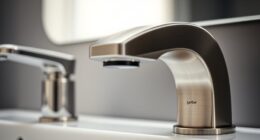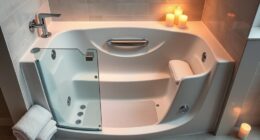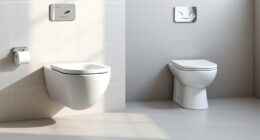We know what you’re thinking – marine toilet systems might not be the most glamorous topic. But hear us out.
Having a functional and efficient toilet system on your boat is crucial for a comfortable and enjoyable boating experience. In this article, we’ll dive into the different types of marine toilet systems, how they work, key components to consider, and essential maintenance tips.
Get ready to master the art of marine toilets and make your boating trips a breeze.
Key Takeaways
- Gravity flush systems are simple, reliable, and require minimal maintenance.
- Vacuum flush systems are more efficient and use less water per flush.
- Marine toilet systems can use either a vacuum flush system or a macerator pump for waste disposal.
- Marine toilets can have either holding tanks or treatment systems for waste disposal.
Types of Marine Toilet Systems
There are several types of marine toilet systems available for boaters to choose from. When it comes to marine toilet installation, it’s important to consider the specific needs and requirements of your boat.

One common type is the gravity flush system, which uses gravity to remove waste from the toilet bowl. Gravity flush systems are simple and reliable, requiring minimal maintenance.
Another option is the vacuum flush system, which creates a strong suction to flush waste away. Vacuum flush systems are more efficient, using less water per flush.
Both of these systems have their own set of benefits. Gravity flush systems are simple and reliable, requiring minimal maintenance. On the other hand, vacuum flush systems are more efficient, using less water per flush.
Ultimately, the choice between these types of marine toilet systems comes down to personal preference and the specific needs of your boat.

Working Mechanisms of Marine Toilets
Discussing the working mechanisms of marine toilets, we’ll explore the various processes involved in waste removal and flushing.
Flushing mechanisms in marine toilets are designed to efficiently and effectively remove waste from the toilet bowl. One common flushing mechanism found in marine toilets is the vacuum flush system. This system uses a vacuum pump to create suction and remove waste from the bowl.
Another flushing mechanism is the macerator pump, which grinds up waste before it’s pumped out.
Waste disposal solutions in marine toilet systems include holding tanks and treatment systems. Holding tanks store waste until it can be properly disposed of at a designated pump-out station.

Treatment systems use chemicals or biological processes to break down waste and reduce odors before it’s discharged into the water.
Key Components of Marine Toilet Systems
Let’s explore the key components of marine toilet systems and how they contribute to the overall functionality and efficiency of onboard sanitation. Marine toilet installation involves several essential components that work together to ensure proper functioning and hygiene.
One of the key components is the toilet bowl, which is designed to be compact and durable, capable of withstanding the harsh marine environment. The bowl is typically made of high-quality materials such as porcelain or plastic, providing both comfort and resistance to corrosion.
Another crucial component is the flushing mechanism, which can vary depending on the type of marine toilet. Manual toilets require a hand pump to flush waste, while electric toilets utilize a motorized pump for a more convenient and effortless operation.

Additionally, marine toilets are equipped with a waste holding tank, which stores the waste until it can be properly disposed of. These tanks are designed to be leak-proof and odor-resistant, ensuring a clean and hygienic environment onboard.
The table below summarizes the key components of marine toilet systems and their benefits:
| Component | Benefits |
|---|---|
| Toilet Bowl | Compact, durable, and resistant to corrosion |
| Flushing Mechanism | Convenient and effortless operation |
| Waste Holding Tank | Leak-proof and odor-resistant, maintaining a clean environment |
Considerations for Choosing a Marine Toilet
Now that we’ve explored the key components of marine toilet systems, let’s delve into the considerations we need to keep in mind when choosing a marine toilet.
When it comes to marine toilet installation, it’s crucial to consider the available space on the boat and the plumbing requirements. The size and shape of the toilet should be compatible with the boat’s layout.

Additionally, it’s important to consider the type of toilet system that best suits your needs. One option to consider is the composting toilet, which offers several benefits. Composting toilets are environmentally friendly, as they don’t require water for flushing. They also eliminate the need for holding tanks and can reduce odors on board.
Furthermore, composting toilets are easy to install and maintain, making them a convenient option for marine toilet systems.
Maintenance Tips for Marine Toilet Systems
When maintaining marine toilet systems, it’s important to regularly clean and inspect all components for optimal performance and to prevent any potential issues. Proper maintenance can help extend the lifespan of the system and ensure its efficient operation. Here are some key maintenance tips for marine toilet systems:
- Perform routine cleaning of the toilet bowl and seat using marine-grade cleaning agents to prevent the buildup of bacteria and odors.
- Regularly check and tighten any loose connections or fittings to prevent leaks.
- Inspect the pump and valves for any signs of wear or damage, and replace as necessary.
- Use marine toilet paper that’s specifically designed to dissolve quickly in water to prevent clogs.
- Conduct regular freshwater flushes to help keep the system clean and minimize odors.
- If troubleshooting is needed, consult the manufacturer’s manual or seek professional assistance to address any issues promptly.
Frequently Asked Questions
Are Marine Toilet Systems Suitable for Use in Freshwater Environments, or Are They Exclusively Designed for Saltwater Use?
Marine toilet systems, regardless of their suitability for freshwater environments or exclusivity for saltwater use, require consideration of freshwater compatibility and specific maintenance requirements to ensure optimal performance and longevity.

What Is the Average Lifespan of a Marine Toilet System, and Are There Any Factors That Can Prolong or Shorten Its Lifespan?
Factors affecting the lifespan of marine toilet systems include usage frequency, maintenance practices, and water quality. Regular cleaning, proper disposal of waste, and avoiding harsh chemicals can prolong their lifespan.
Can a Marine Toilet System Be Installed in Any Type of Boat, or Are There Specific Requirements or Limitations?
Marine toilet systems can be installed in various types of boats, but specific requirements and limitations exist. Installation requirements include proper plumbing connections and adequate space. Maintenance considerations involve regular cleaning and inspection for optimal performance and longevity.
Are There Any Regulations or Guidelines That Govern the Installation or Use of Marine Toilet Systems in Certain Geographic Areas or Bodies of Water?
Regulations and guidelines vary in different geographic areas, affecting the installation and use of marine toilet systems. It’s important to understand these requirements to ensure compliance and avoid penalties or restrictions.
Are There Any Eco-Friendly Options Available for Marine Toilet Systems, Such as Composting or Low-Flush Models?
There are eco-friendly options available for marine toilet systems, such as composting or low-flush models. Composting marine toilets use natural processes to break down waste, while low-flush models conserve water. These options offer benefits for the environment and boaters alike.

Conclusion
In conclusion, marine toilet systems are the unsung heroes of every boat, silently and efficiently handling waste disposal. Just like a trusted navigator, these systems steer us towards a clean and comfortable journey on the open waters.
By understanding the different types, working mechanisms, and key components of marine toilets, along with proper maintenance and considerations, we can ensure smooth sailing and a pleasant experience for all on board.
So, let’s embrace these vital systems and let them guide us towards a worry-free adventure at sea.










